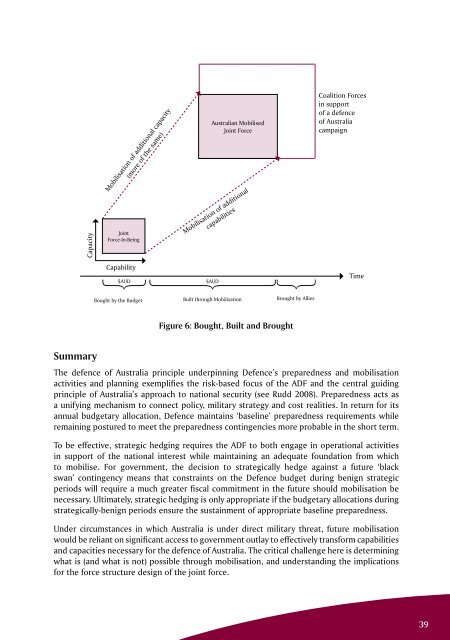190%202013%20Mar_Apr
190%202013%20Mar_Apr
190%202013%20Mar_Apr
Create successful ePaper yourself
Turn your PDF publications into a flip-book with our unique Google optimized e-Paper software.
Capacity<br />
Summary<br />
Mobilisation of additional capacity<br />
(more of the same)<br />
Joint<br />
Force-In-Being<br />
Capability<br />
$AUD<br />
Bought by the Budget<br />
Australian Mobilised<br />
Joint Force<br />
Mobilisation of additional<br />
capabilities<br />
$AUD<br />
Built through Mobilisation<br />
Figure 6: Bought, Built and Brought<br />
Brought by Allies<br />
Coalition Forces<br />
in support<br />
of a defence<br />
of Australia<br />
campaign<br />
Time<br />
The defence of Australia principle underpinning Defence’s preparedness and mobilisation<br />
activities and planning exemplifies the risk-based focus of the ADF and the central guiding<br />
principle of Australia’s approach to national security (see Rudd 2008). Preparedness acts as<br />
a unifying mechanism to connect policy, military strategy and cost realities. In return for its<br />
annual budgetary allocation, Defence maintains ‘baseline’ preparedness requirements while<br />
remaining postured to meet the preparedness contingencies more probable in the short term.<br />
To be effective, strategic hedging requires the ADF to both engage in operational activities<br />
in support of the national interest while maintaining an adequate foundation from which<br />
to mobilise. For government, the decision to strategically hedge against a future ‘black<br />
swan’ contingency means that constraints on the Defence budget during benign strategic<br />
periods will require a much greater fiscal commitment in the future should mobilisation be<br />
necessary. Ultimately, strategic hedging is only appropriate if the budgetary allocations during<br />
strategically-benign periods ensure the sustainment of appropriate baseline preparedness.<br />
Under circumstances in which Australia is under direct military threat, future mobilisation<br />
would be reliant on significant access to government outlay to effectively transform capabilities<br />
and capacities necessary for the defence of Australia. The critical challenge here is determining<br />
what is (and what is not) possible through mobilisation, and understanding the implications<br />
for the force structure design of the joint force.<br />
39


